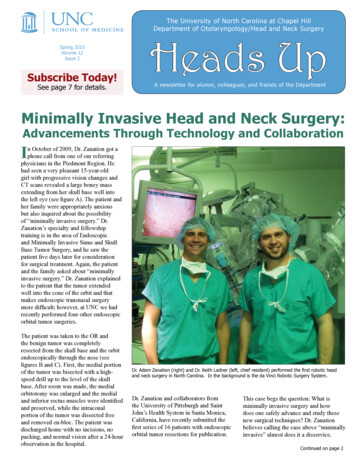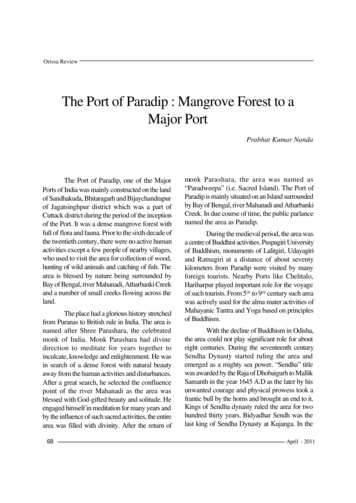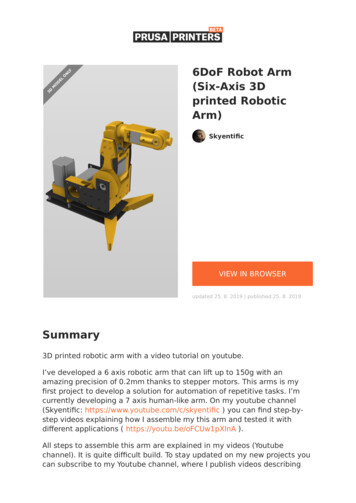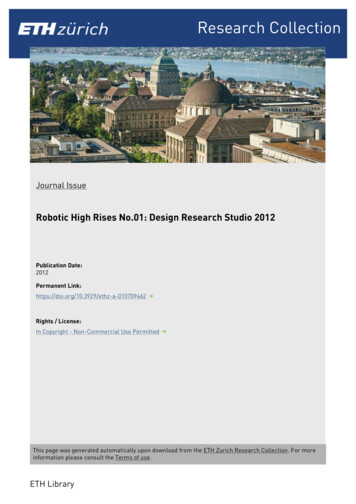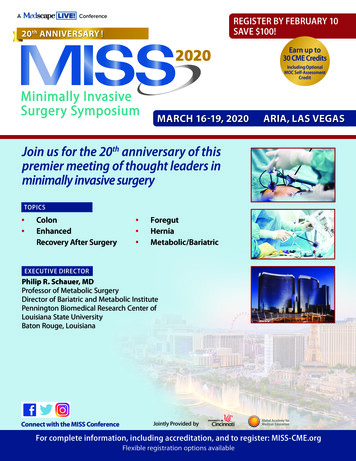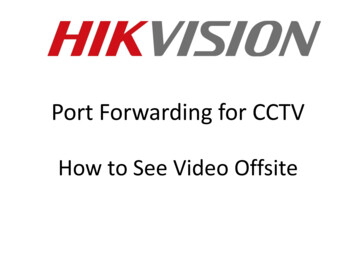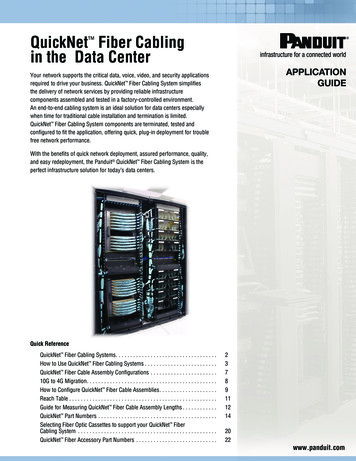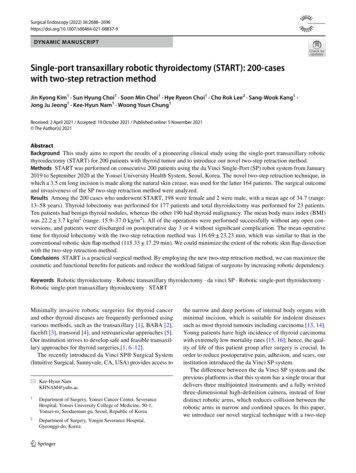
Transcription
Surgical Endoscopy (2022) 8837-9and Other Interventional TechniquesDYNAMIC MANUSCRIPTSingle‑port transaxillary robotic thyroidectomy (START): 200‑caseswith two‑step retraction methodJin Kyong Kim1 · Sun Hyung Choi1 · Soon Min Choi1 · Hye Ryeon Choi1 · Cho Rok Lee2 · Sang‑Wook Kang1 ·Jong Ju Jeong1 · Kee‑Hyun Nam1 · Woong Youn Chung1Received: 2 April 2021 / Accepted: 19 October 2021 / Published online: 5 November 2021 The Author(s) 2021AbstractBackground This study aims to report the results of a pioneering clinical study using the single-port transaxillary roboticthyroidectomy (START) for 200 patients with thyroid tumor and to introduce our novel two-step retraction method.Methods START was performed on consecutive 200 patients using the da Vinci Single-Port (SP) robot system from January2019 to September 2020 at the Yonsei University Health System, Seoul, Korea. The novel two-step retraction technique, inwhich a 3.5 cm long incision is made along the natural skin crease, was used for the latter 164 patients. The surgical outcomeand invasiveness of the SP two-step retraction method were analyzed.Results Among the 200 cases who underwent START, 198 were female and 2 were male, with a mean age of 34.7 (range:13–58 years). Thyroid lobectomy was performed for 177 patients and total thyroidectomy was performed for 23 patients.Ten patients had benign thyroid nodules, whereas the other 190 had thyroid malignancy. The mean body mass index (BMI)was 22.2 3.7 kg/m2 (range: 15.9–37.0 kg/m2). All of the operations were performed successfully without any open conversions, and patients were discharged on postoperative day 3 or 4 without significant complication. The mean operativetime for thyroid lobectomy with the two-step retraction method was 116.69 23.23 min, which was similar to that in theconventional robotic skin flap method (115.33 17.29 min). We could minimize the extent of the robotic skin flap dissectionwith the two-step retraction method.Conclusions START is a practical surgical method. By employing the new two-step retraction method, we can maximize thecosmetic and functional benefits for patients and reduce the workload fatigue of surgeons by increasing robotic dependency.Keywords Robotic thyroidectomy · Robotic transaxillary thyroidectomy · da vinci SP · Robotic single-port thyroidectomy ·Robotic single-port transaxillary thyroidectomy · START Minimally invasive robotic surgeries for thyroid cancerand other thyroid diseases are frequently performed usingvarious methods, such as the transaxillary [1], BABA [2],facelift [3], transoral [4], and retroauricular approaches [5].Our institution strives to develop safe and feasible transaxillary approaches for thyroid surgeries.[1, 6–12].The recently introduced da Vinci SP Surgical System(Intuitive Surgical, Sunnyvale, CA, USA) provides access to* Kee‑Hyun NamKHNAM@yuhs.ac1Department of Surgery, Yonsei Cancer Center, SeveranceHospital, Yonsei University College of Medicine, 50‑1,Yonsei‑ro, Seodaemun‑gu, Seoul, Republic of Korea2Department of Surgery, Yongin Severance Hospital,Gyeonggi‑do, Korea13Vol:.(1234567890)the narrow and deep portions of internal body organs withminimal incision, which is suitable for indolent diseasessuch as most thyroid tumours including carcinoma [13, 14].Young patients have high incidence of thyroid carcinomawith extremely low mortality rates [15, 16]; hence, the quality of life of this patient group after surgery is crucial. Inorder to reduce postoperative pain, adhesion, and scars, ourinstitution introduced the da Vinci SP system.The difference between the da Vinci SP system and theprevious platforms is that this system has a single trocar thatdelivers three multijointed instruments and a fully wristedthree-dimensional high-definition camera, instead of fourdistinct robotic arms, which reduces collision between therobotic arms in narrow and confined spaces. In this paper,we introduce our novel surgical technique with a two-step
Surgical Endoscopy (2022) 36:2688–26962689method using the da Vinci SP system, which can increaserobotic efficiency and minimize invasiveness.Operative procedureMethodUnder general anaesthesia, the patient was placed in asupine position. A backrest was placed underneath thepatient to allow neck extension in order to provide a fullyexposed surgical space to the surgeon. The arm on thelesion-side was not fixed but draped to allow movementso that it could be raised or stretched laterally during theoperation. Generally, the lesion-side arm was raised during flap dissection and regulated as occasion demandsduring the robotic console time. A 3.5 cm incision wasmade along the natural skin crease. Flap dissection wasperformed as in general robotic transaxillary thyroidectomy. The detailed procedure has been described in previous studies [6, 19].PatientsSingle-port transaxillary robotic thyroidectomy (START)was performed on consecutive 200 patients using the daVinci SP robot system from January 2019 to September2020. Among them, 36 patients underwent robotic thyroidectomy involving a conventional robotic skin flap method(conventional method) with a 3.5 cm skin incision alongthe natural skin crease [1]. From the 37th case, we appliedthe novel two-step retraction technique (two-step method)to minimize flap invasiveness and to obtain a stable view.The preoperative evaluation of all the thyroid nodulesincluded fine needle aspiration biopsy (FNAB). Whenthyroid carcinoma was suspected, high-resolution stagingultrasonography and neck and chest computed tomography (CT) were performed. The ultrasound examinationsincluded both thyroid lobes and all the neck levels (I–VI)[17]. For benign tumours, surgical management wasindicated as follows: (1) follicular/Hurthle cell lesionsof diameter 5 cm and (2) palpable benign tumors ofdiameter 4 cm.Cases of thyroid nodules without lateral neck or distant metastasis were enrolled in this study; those involvingtumours with posterior capsular invasion or extension toan adjacent structure were excluded due to the possibilityof injury to the recurrent laryngeal nerve (RLN), trachea,or oesophagus during the procedure. Cases with goitre orGrave’s disease were also excluded due to the high riskinvolved.In thyroid cancer, the extents of thyroidectomy weredetermined according to the guidelines issued by the 2015American Thyroid Association [18]. Twenty-three patientswith bilateral lesions, adjacent muscle invasion duringsurgery, or more than five central lymph node metastasisunderwent total thyroidectomy. Prophylactic ipsilateralcentral compartment neck dissection was performed forall the cancer patients.Details on the clinical and pathologic characteristics,operation type, operative time, postoperative hospital stay,and complications were obtained from our institutionaldatabase. This study was approved by Yonsei University’sinstitutional review board (4–2020-0149), and informedconsent from the patients was waived owing to the retrospective nature of this study.Skin flap creation with the conventional methodSkin flap creation with the two‑step methodThe preoperative patient position was the same as that inthe conventional method. A 3.5 cm incision was made alongthe natural skin crease on the lesion-side axilla. With thearm raised, flap dissection was performed over the anteriorsurface of the pectoralis major muscle, directly toward thesternal notch to find the sternocleidomastoid muscle (SCM).After the SCM was identified below the platysma and itstwo heads dissected, a narrow (width 3 cm) version of theChung’s retractor was inserted, corresponding to the sizeof the incision. The skin with a small portion of the SCMsternal head was then elevated. The raised arm was stretchedlaterally to straighten the robotic approach around the posterior neck area. After robotic docking, the subplatysmallayer was further dissected to obtain sufficient space. Thetwo heads of the SCM were then dissected completely tofind the strap muscles. The thyroid was found below thestrap muscles and after obtaining sufficient space, the surgical assistant inserted the Chung’s retractor below the strapmuscles, completing the redocking; this is referred to as “thesecond step retraction.” The step-by-step robotic procedureafter the first docking is shown in Fig. 1 and video.Robotic thyroidectomy techniqueThyroidectomy was performed as in conventionaltransaxillary robotic surgery [6]. The robotic camera wasemployed at the bottom of the SP trocar. The three-armmethod was used: Cardiere on the upper site, and twoMaryland dissectors on the left and right of the singleport trocar. As the bipolar energy source, Erbe (Erbe USAInc, Marietta, GA) in the SWIFT COAG mode at a power13
2690Surgical Endoscopy (2022) 36:2688–2696Fig. 1 Two-step retraction operative procedure. A Robotic consoleview after the first docking. B Widening of the skin flap with the daVinci SP. C Working space creation between the two heads of theSCM. D Finding thyroid beneath the strap muscles. E The seconddocking creating sufficient working space. F: Completion of the second dockinglevel of 4–5 was connected to the bilateral Maryland dissectors. Fine upper-pole dissection was performed savingthe external branch of RLN and superior parathyroid. Further, the ipsilateral RLN was identified and central compartment dissection was simultaneously performed on thecancer patients. While tracing the nerve, the ipsilateralthyroid was detached from the trachea and a specimen wasextracted through an axillary incision. The detailed thyroid lobectomy procedure has been presented in a previousstudy [20].For total thyroidectomy, intraoperative nerve monitoring was routinely applied to reduce the risks of RLN injury13
Surgical Endoscopy (2022) 36:2688–2696[21]. Contralateral thyroidectomy was performed after theextraction of the ipsilateral specimen to acquire more working space for the robotic arms. The trachea was pushed downwith a suction assistant, the contralateral upper-pole was drawndownward using the robotic grasper, and the superior thyroidalvessel was identified and ligated. After upper-pole dissection,all of the strap muscles around the remnant thyroid were dissected. The contralateral RLN was then identified betweenthe remnant thyroid and the trachea was pushed down by thesuction assistant. The RLN was traced above the trachea anddetached as a specimen. After the extraction of the contralateral thyroid through an axillary incision, a closed suction drainwas inserted for prevention of emergent bleeding or seroma.The wound was closed layer-by-layer.The role of an assistantDuring the whole procedure, one assistant (a field surgeon ora physician assistant(PA)) joined the operation. When creatingthe robotic flap, the assistant helped retract the skin flap withspecially designed fiber optic device. The assistant also supported the installation of Chung’s retractor, robotic docking,and regulation of robotic location after docking. In the case ofthe two-step method, the assistant helped loosen the Chung’sretractor and indwell the retractor again beneath the strap muscle in the operation field. Also, with a 50 cm curved suctioncatheter, the assistant aided in counter-traction, smoke emission, and securing the trachea during the whole console time.Postoperative managementAll patients were fitted with a drain to prevent complicationsfrom postoperative seroma or hematoma and were dischargedon the third or fourth postoperative day(POD) after drainremoval. After surgery, all of the patients received levothyroxine to maintain thyroid function or to suppress the TSHlevel, as required. Hypoparathyroidism, defined as reductionin the serum iPTH level below the normal range regardless ofhypercalcaemic symptoms [22], was managed with calciumreplacement on occurrence.Statistical analysisDetails on the clinical characteristics, pathological characteristics, operation data, and complications were obtained fromour institutional database. The parameter differences wereanalysed using student t-tests when appropriate. All statistical analyses were performed using the IBM SPSS Statisticsfor Windows software (Version 25.0; IBM Corp., Armonk,NY), and the statistically significant difference was definedas p 0.05.2691Table 1 Clinical characteristics of patients (n 200) and pathologicresult of patients with thyroid cancer (n 190)VariablesMean SDRangeAge (years)Sex ratio (male:female)Extent of thyroidectomy (lobectomy: BTT)Pathologic type (malignant:benign)BMIPostoperative hospital stay (days)Tumor size (cm)Pathology, n (%)Papillary carcinomaFollicular carcinomaMultifocality, n (%)Bilaterality, n (%)Central lymph node, nRetrievedMetastaticT stage, n (%)T1/T2/T3/T4N stageN0/N1aTNM stage, n (%)I/II/III/IV34.7 7.92:198177:23190:1022.2 3.73.0 0.10.9 0.813–5815.9–37.02–40.2–5187 (98.4)3 (1.6)32 (16.6)20 (10.4)3.6 3.30.8 1.3171/13/5/10–180–6117/73190/0/0/0ResultAll operations, including thyroid lobectomy or total thyroidectomy, were performed by a single surgeon (Kee-HyunNam). Table 1 lists the clinical characteristics of the 200patients who underwent START and the pathologic resultsof 190 patients with thyroid cancer. Among the 200 cases,198 were female and 2 were male, with a mean age of 34.7(range: 13–58 years). Thyroid lobectomy was performed for177patients and total thyroidectomy was performed for 23patients. Ten patients had benign thyroid nodules, whereasthe other 190 had thyroid malignancy. The mean body massindex (BMI) was 22.2 3.7 kg/m2 (range: 15.9–37.0 kg/m2).Except for two patients who wanted to prolong the hospital stay for four days after the operation, patients were discharged on the third POD.The pathologic characteristics of the 190 patients withthyroid cancer were analysed. The mean tumour size was0.9 0.8 (range: 0.2–5) cm; 187 patients had papillary thyroid carcinoma (PTC) and 3 had minimally invasive follicular thyroid carcinoma. Thirty-two patients had multifocality( 1 PTC foci on one side of the thyroidectomy specimen),and twenty had bilaterality. The number of retrieved centrallymph nodes (CLNs) was 3.6 3.3 (range: 0–18) and thenumber of metastatic CLNs was 0.8 1.3 (range: 0–6).The operative data of thyroid lobectomy cases withSTART were compared between the conventional method13
2692Surgical Endoscopy (2022) 36:2688–2696Table 2 Differences in thyroidlobectomy approachesTotal OP time (min)Working space (min)Docking (min)Console (min)Lobectomy with conventionalskin flap (n 36)Lobectomy with double-docking p-valuemethod (n 141)115.3 17.334.1 7.55.2 1.748.0 14.2116.7 23.228.9 10.93.8 2.060.0 18.50.7000.0070.0000.000N number, OP operationFig. 3 Various version of Chung’s retractors. Currently, the minimalsized Chung’s retractor (right) is used for two-step methodOne of the postoperative scars after 6 month from thesurgery is provided in Fig. 2. After the complete healing, itbecame almost indistinguishable from the previous naturalskin crease before the operation.Fig. 2 Cosmetic outcome 6 months after surgeryand two-step method (Table 2). Mean total operativetime for thyroid lobectomy using conventional methodgroup and two-step method group were 115.3 17.3 and116.7 23.2 min, respectively (p 0.700). The working space, docking, and console time were 34.1 7.5 and28.9 10.9 min (p 0.007) 5.2 1.7 and 3.8 2.0 min(p 0.000), and 48.0 14.2 and 60.0 18.5 min (p 0.000),respectively. Operation time for total thyroidectomy was alsocalculated. All of the 23 total thyroidectomy cases wereperformed with two-step method. The total operation time,working space, docking, and console time were 176.6 21.1,30.3 11.0, 4.9 1.8, and 115.4 19.9 min, respectively.Two patients had transient hypoparathyroidism thatrecovered completely after 2 months of calcium replacement. There were no cases of permanent hypoparathyroidism, RLN injury, seroma, or bleeding.13DiscussionThe da Vinci SP platform was originally designed for procedures involving deep and narrow working spaces. Sincethe development of the robot-assisted endoscopic thyroidsurgery by Chung et al. [23] in 2007, our institution hasactively performed more than 7500 procedures (July 2020)using the da Vinci Si or Xi platforms. With the introductionof the SP system, however, our institution has considered thepossibility of reducing invasiveness through this method.The da Vinci SP system has been used for thyroid surgery at the Yonsei University Severance Hospital, Seoul,Korea since December 2018. For the first four cases in2018, the gas insufflation method was employed [20].However, several layers of cervical muscles hindered theapproach to the thyroid from the axilla, demanding considerable effort and time with an unstable view. Hence, wereverted to the gasless method and performed additional
Surgical Endoscopy (2022) 36:2688–2696200 START. Thus far, to the best of our knowledge, thisis the first study to perform as many as 200 thyroidectomycases using the da Vinci SP platform.Reduction of the length of the incision was initiallyattempted using this new apparatus [20]. A narrow version of the Chung’s retractor (Fig. 3) was developed andfibre optics were used during flap dissection. Moreover,the skin flap for robotic thyroidectomy became inevitablynarrow due to visual restriction. We realized that upperpole dissection with a narrow flap was simpler with a laterally extended arm than an upwardly raised one. Withthe previous Si or Xi platform, we positioned the arm tobe upwardly raised in order to ensure least distance fromthe axilla to thyroid, prohibiting collision between thefour robotic arms [1]. Using the SP system, the distancebetween the axilla and thyroid was no longer a problem.Nonetheless, longer distance with a small incision wastroublesome when creating the working space. The retractor applied during flap dissection could not reach the surface of the thyroid beneath the strap muscles. Hence, wedid not fix the lesion-side arm but left it free to allowmovement during surgery. We raised the arm during flapdissection and extended it laterally during the consoletime. When intense concentration was needed on the central compartment, we again raised the arm to facilitate thedirect linear approach.The other problem was that dissection of the skin flapfor robotic thyroidectomy around the strap muscles was notvisually safe due to the minimization of the incision. We2693could not easily secure a clear view around the strap musclewith a 3.5 cm incision. Although there were no specific complications, we recognized the necessity for improving theflap dissection. Hence, we employed the two-step method,where we dissected only half the flap, applied docking, completed flap dissection with the robotic console, and redockedthe SP robot.In addition to facilitating a deep and narrow approach, theother advantage of the SP is the ease of docking, de-docking,and redocking. In the Xi or Si systems, four robotic instruments and four robotic trocars had to be moved by adjustingthe joints of the four robotic arms, while in the SP, with allthe instruments within the trocar, only the single-port trocarneeded to be moved. This made the two-step procedure possible without any delay in the operative time.For the surgeon, the effect of two-step method was apparent; the fatigue of the surgeon and the assistant during flapdissection was reduced. Instead of focusing on retracting allthe strap muscles upward, we were able to work between themuscles by spreading the strap muscles with the robotic console, which allowed sufficient working space for the operation. This is also significant since robotic dependency hasincreased during robotic thyroidectomy.Moreover, not only the incision length but also the extentof flap dissection for thyroidectomy was decreased using theSP system (Fig. 4A, B). With considerable time and effort,we realized that an entire conventional skin flap for roboticthyroidectomy was not necessary for thyroidectomy withthe SP system.Fig. 4 Comparison of the extent of skin flap dissection and the cosmetic outcome. A Comparison between conventional skin flap and SP skinflap before docking. B Widened SP skin flap after the 1st docking in the two-step method13
2694Although we were comfortable using four linear roboticinstruments initially, with increasing experience over time,we became accustomed to the haptic, flexible SP instrumentsand could freely manipulate the SP system and continuouslyattempt to render a narrower flap. With the current extent ofthe robotic transaxillary flap using the SP system, we areuncertain about the benefits of other robotic approaches suchas BABA approach, which requires four incisions including two axillary incisions,(2) or transoral thyroidectomy,(4)which occasionally needs an axillary incision for thyroidremoval and drain insertion. Furthermore, for the SP system,a spherical space needs to be controlled without restriction(Fig. 5). Beneath the skin, we believe that the transaxillaryflap is advantageous for creating sufficient working spacefor the SP system, without encountering the bone structure.By applying changes in the patient position during theoperation, injury to the brachial plexus or radial, ulnar, andmedian nerve injuries was avoided in western patient populations [24–29]. If raising the lesion-side arm is not possible, we recommend a laterally stretched arm with the use oflonger fibre optics during flap dissection to reach the SCMfrom the axillary incision.Currently, a flexible ultrasonic vibration energy device suchas the harmonic scalpel is not available due to technical difficulties, which ensued the da Vinci SP system to be equippedwith the Erbe. Despite the unfamiliarity with the new energysource, no specific complication occurred in our 200-caseexperience, and it is noteworthy that there are benefits fromthe usage of the Erbe compared to the harmonic scalpel. Inthe SP system, both sides of the flexible Maryland dissectorscan be connected to the Erbe and every space of the surgical field can be easily accessed without considerable effort.Moreover, the sharp Maryland forceps facilitate sophisticateddissection, while tracing the nerve and detaching the berryligament from the nerve without significant thermal injury.Although we could not provide the statistical data due to theSurgical Endoscopy (2022) 36:2688–2696retrospective nature of this study, the quality of the patient’svoice after the START is significantly outstanding comparedwith that treated with any other energy device. The comparison of thermal damage between bipolar energy and ultrasonicenergy devices are controversial.[30–41]. Among them, Suttonet al.[42] reported that bipolar energy produce smaller increasein the temperature than harmonic scalpel. Due to the sharpapplicators (Maryland) and multiple, short firing of the bipolarenergy, we believe we could minimize the thermal damage.This particular subject will be further investigated hereafter.Our study has revealed satisfactory results with a large sample of 200 patients who underwent START using the da VinciSP system. As expected, the axillary scar became almost indistinguishable over time (Fig. 2). We assume that this is due tothe fact that we used the natural skin crease [43–46]. However,the retrospective nature of the analysis, single surgeon experience, and lack of comparative data for open or other surgicalplatforms are the limitations of the study. Furthermore, longterm oncological outcomes such as the survival, recurrence,and quality of life need to be evaluated. Therefore, multi-centreprospective studies are required to further evaluate the role ofthe da Vinci SP platform in thyroid surgeries.We can conclude that START with the da Vinci SP systemis a practical surgical method with minimal invasiveness, particularly when the two-step method is applied. This methodoffers cosmetic and functional benefits to the patients andreduces the workload fatigue of surgeons.Supplementary Information The online version contains supplementary material available at https://d oi.o rg/1 0.1 007/s 00464-0 21-0 8837-9.Acknowledgements The authors thank the Severance Robot team,especially Ho Young Kim and Hee Chang Yu, for their technicalsupport.Funding This research did not receive any specific grant from fundingagencies in the public, commercial, or not-for-profit sectors.DeclarationsDisclosures Drs. Jin Kyong Kim MD, Sun Hyung Choi MD, SoonMin Choi MD, Hye Ryeon Choi MD, Cho Rok Lee MD, Sang-WookKang MD, PhD, Jong Ju Jeong MD, Kee-Hyun Nam MD, PhD, andWoong Youn Chung MD, PhD have no conflicts of interest or financialties to disclose.Open Access This article is licensed under a Creative Commons Attribution 4.0 International License, which permits use, sharing, adaptation, distribution and reproduction in any medium or format, as longas you give appropriate credit to the original author(s) and the source,provide a link to the Creative Commons licence, and indicate if changeswere made. The images or other third party material in this article areincluded in the article's Creative Commons licence, unless indicatedotherwise in a credit line to the material. If material is not included inthe article's Creative Commons licence and your intended use is notpermitted by statutory regulation or exceeds the permitted use, you willFig. 5 Spherical working space required for the SP system13
Surgical Endoscopy (2022) 36:2688–2696need to obtain permission directly from the copyright holder. To view acopy of this licence, visit http:// creat iveco mmons. org/ licen ses/ by/4. 0/.References1. Kang S-W, Jeong JJ, Yun J-S, Sung TY, Lee SC, Lee YSet al (2009) Robot-assisted endoscopic surgery for thyroidcancer: experience with the first 100 patients. Surg Endosc23(11):2399–24062. Lee KE, Rao J, Youn Y-K (2009) Endoscopic thyroidectomywith the da Vinci robot system using the bilateral axillary breastapproach (BABA) technique: our initial experience. Surg Laparoscopy Endoscopy Percutaneous Tech 19(3):e71–e753. Singer MC, Seybt MW, Terris DJ (2011) Robotic facelift thyroidectomy: I. Preclinical simulation and morphometric assessment.Laryngoscope 121(8):1631–16354. Richmon JD, Kim HY (2017) Transoral robotic thyroidectomy(TORT): procedures and outcomes. Gland Surg 6(3):2855. Kandil E, Saeed A, Mohamed SE, Alsaleh N, Aslam R, Moulthrop T (2015) Modified robotic-assisted thyroidectomy: an initial experience with the retroauricular approach. Laryngoscope125(3):767–7716. Ryu HR, Kang S-W, Lee SH, Rhee KY, Jeong JJ, Nam K-H et al(2010) Feasibility and safety of a new robotic thyroidectomythrough a gasless, transaxillary single-incision approach. J AmColl Surg 211(3):e13–e197. Kang S-W, Lee SC, Lee SH, Lee KY, Jeong JJ, Lee YS et al (2009)Robotic thyroid surgery using a gasless, transaxillary approachand the da Vinci S system: the operative outcomes of 338 consecutive patients. Surgery 146(6):1048–10558. Kang S-W, Jeong JJ, Nam K-H, Chang HS, Chung WY, ParkCS (2009) Robot-assisted endoscopic thyroidectomy for thyroidmalignancies using a gasless transaxillary approach. J Am CollSurg 209(2):e1–e79. Kang S-W, Park JH, Jeong JS, Lee CR, Park S, Lee SH et al (2011)Prospects of robotic thyroidectomy using a gasless, transaxillaryapproach for the management of thyroid carcinoma. Surgical Laparoscopy Endoscopy & Percutaneous Techniques 21(4):223–22910. Lee J, Chung WY (2012) Current status of robotic thyroidectomyand neck dissection using a gasless transaxillary approach. CurrOpin Oncol 24(1):7–1511. Chung WY (2012) Pros of robotic transaxillary thyroid surgery: its impact on cancer control and surgical quality. Thyroid22(10):986–98712. Ryu HR, Lee J, Park J-H, Kang S-W, Jeong JJ, Hong J-Y et al(2013) A comparison of postoperative pain after conventional open thyroidectomy and transaxillary single-incisionrobotic thyroidectomy: a prospective study. Ann Surg Oncol20(7):2279–228413. Hundahl SA, Cady B, Cunningham MP, Mazzaferri E, McKee RF,Rosai J et al (2000) Initial results from a prospective cohort studyof 5583 cases of thyroid carcinoma treated in the United Statesduring 1996: an American college of surgeons commission oncancer patient care evaluation study. Cancer 89(1):202–21714. Gosnell JE, Clark OH (2008) Surgical approaches to thyroidtumors. Endocrinol Metab Clin North Am 37(2):437–45515. La Vecchia C, Malvezzi M, Bosetti C, Garavello W, BertuccioP, Levi F et al (2015) Thyroid cancer mortality and incidence: aglobal overview. Int J Cancer 136(9):2187–219516. Lim H, Devesa SS, Sosa JA, Check D, Kitahara CM (2017) Trendsin thyroid cancer incidence and mortality in the United States,1974–2013. JAMA 317(13):1338–1348269517. Choi JS, Kim J, Kwak JY, Kim MJ, Chang HS, Kim E-K (2009)Preoperative staging of papillary thyroid carcinoma: comparisonof ultrasound imaging and CT. Am J Roentgenol 193(3):871–87818. Haugen BR, Alexander EK, Bible KC, Doherty GM, Mandel SJ,Nikiforov YE et al (2016) 2015 American Thyroid Associationmanagement guidelines for adult patients with thyroid nodules anddifferentiated thyroid cancer: the American Thyroid Associationguidelines task force on thyroid nodules and differentiated thyroidcancer. Thyroid 26(1):1–13319. Lee YK, Kim D, Shin DY, Lee CR, Lee EJ, Kang S-W et al(2019) The prognosis of papillary thyroid cancer with initialdistant metastasis is strongly associated with extensive extrathyroidal extension: a retrospective cohort study. Ann Surg Oncol26(7):2200–220920. Kim K, Kang S-W, Kim JK, Lee CR, Lee J, Jeong JJ et al (2020)Robotic transaxillary hemithyroidectomy using the da Vinci SProbotic system: initial experience with 10 consecutive cases. SurgInnov 27(3):256–26421. Horne SK, Gal TJ, Brennan JA (2007) Prevalence and patterns ofintraoperative nerve monitoring for thyroidectomy. OtolaryngolHead Neck Surg 136(6):952–95622. Rivere AE, Brooks AJ, Hayek GA, Wang H, Cors
laterally to straighten the robotic approach around the pos-terior neck area. After robotic docking, the subplatysmal layer was further dissected to obtain sucient space. The . cal analyses were performed using the IBM SPSS Statistics for Windows software (Version 25.0; IBM Corp., Armonk, NY), and the statistically signicant dierence was .
